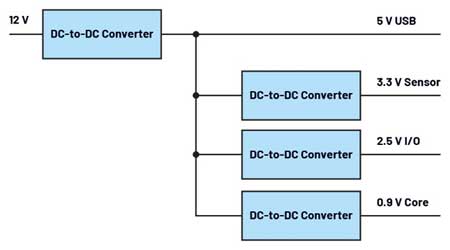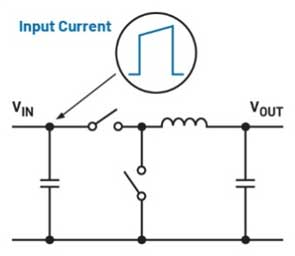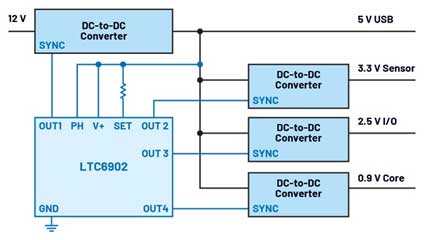Small coup to reduce noise: synchronous switching regulator
Time:2022-12-04
Views:1493
By Frederik Dostal, ADI Field Application Engineer
Most current electronic circuits require multiple supply voltages. Twenty years ago, the universal 5V power supply voltage was sufficient to meet the requirements of TTL logic and all other parts of the system. Today, the input/output (I/O) of the microcontroller needs 2.5V, the core needs 0.9V, and the sensor needs 3.3V. The interface also requires different voltages, such as 5V for USB. In order to improve energy efficiency as much as possible, switching regulators are used in various DC-DC conversion stage applications.
Figure 1 shows a typical power conversion architecture.

Figure 1.1Various Switching Regulators on the 12V Power Rail
If a variety of switching regulators with different switching frequencies are used in the system, not only their fundamental frequencies and harmonics, but also beats corresponding to the frequency difference of different switching regulators will be seen in the spectrum.
By synchronizing different switching regulators in the system, the problem of radiated emission and conducted emission generated at the input of switching regulators can be alleviated. Many DC-DC converter ICs have a SYNC pin to which the clock signal can be supplied. With the help of an internal phase-locked loop (PLL), the switching frequency of each DC-DC converter is set to the frequency provided.

Figure 2. Pulse current on input side generated by step-down converter
This is a good solution, but how to generate this clock signal? Since buck converters generate pulse currents on the input side, it makes sense to ensure that they do not simultaneously draw current from the input source. The phase shifted external SYNC clock signal provides a remedy here. This greatly reduces the conducted emission on the input side of the switching regulator.
ADI LTC6902 is a small additional clock generator used to control the SYNC pins of multiple switching regulators in the system. It is one of the useful tools in the power developer‘s toolbox. This clock device can provide 100kHz to 20MHz clock signals, drive up to four SYNC pins of switching regulators with a certain phase shift, and even use the optional Spread Spectrum (SSFM) to reduce individual peaks in the frequency domain if necessary. In some applications, this technique can meet different EMC requirements.


Figure 3. Using LTC6902 and other external clock generator modules to solve the clock problem
Figure 3 shows the power supply architecture using LTC6902 polyphase oscillator in Figure 1. It is powered by 5V voltage. This voltage is generated by a step-down converter that converts 12V to 5V. For switching regulators, if they start independently with their own internal oscillator first, and then provide an external clock, there is generally no problem. Detailed information can be found in the data manual of the corresponding switching regulator.
In addition to the 4-phase LTC6902, there are 2-phase LTC6908 and 8-phase LTC6909.
If there are multiple switching regulators on a circuit board, low noise system design can also be achieved. In addition to the usual optimizations (such as selecting a suitable switching regulator IC, optimizing the circuit board layout, and adding various filters), the use of additional clock modules may also be beneficial.
About the author
Frederik Dostal studied microelectronics at Erlangen University in Germany. He began to work in 2001 and set foot in the power management business. He once held various application engineer positions, and worked in Phoenix, Arizona for four years, responsible for switching mode power supply. He joined ADI in 2009 and worked as a field application engineer for power management at ADI in Munich.
|
Disclaimer: This article is transferred from other platforms and does not represent the views and positions of this site. If there is any infringement or objection, please contact us to delete it. thank you! |











